NVIDIA Quadro RTX 4000 Compute Related Benchmarks
We are going to compare the NVIDIA Quadro RTX 4000 to our growing data set.
Geekbench 4
Geekbench 4 measures the compute performance of your GPU using image processing to computer vision to number crunching.
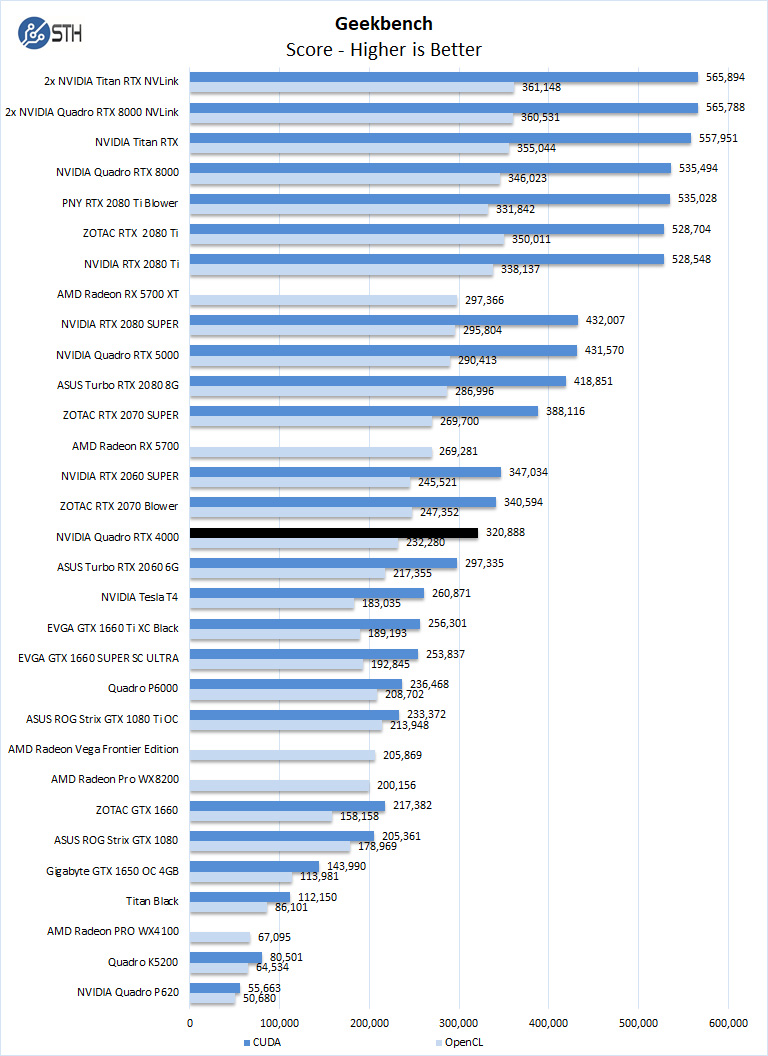
Our first compute benchmark, and we see the NVIDIA Quadro RTX 4000, achieve results close to the ZOTAC RTX 2070 Blower. There is a slight difference in numbers that may be due to cooling differences with the dual-slot blower GPU vs. the single-slot blower of the RTX 4000.
LuxMark
LuxMark is an OpenCL benchmark tool based on LuxRender.
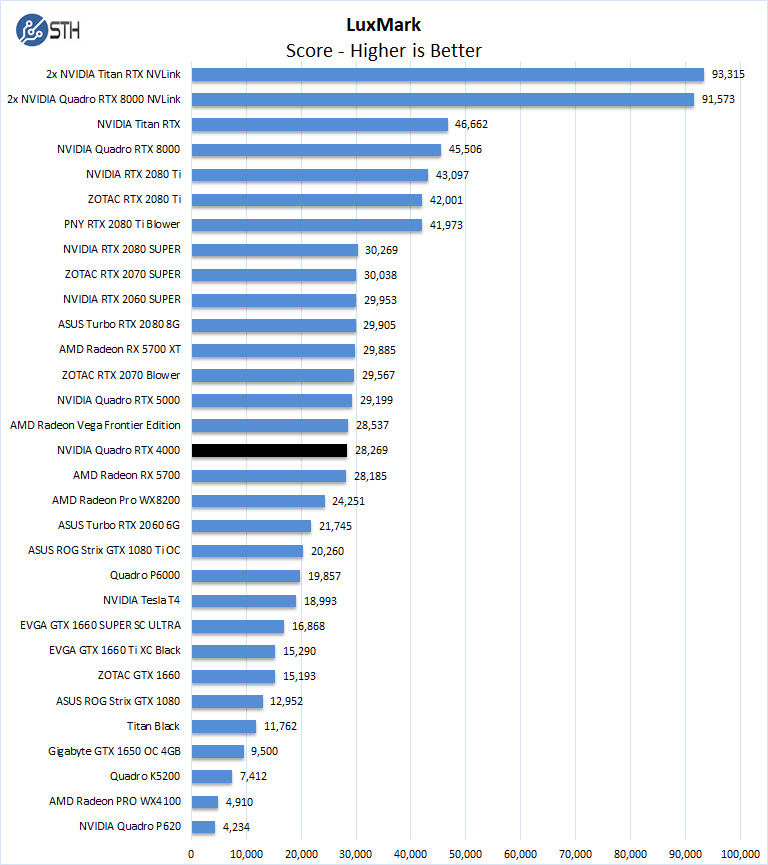
Like our Geekbench results, we find a slight difference between the NVIDIA Quadro RTX 4000 and ZOTAC RTX 2070 Blower. It is interesting to see the RTX 4000 comes close to the RTX 5000 with this benchmark.
AIDA64 GPGPU
These benchmarks are designed to measure GPGPU computing performance via different OpenCL workloads.
- Single-Precision FLOPS: Measures the classic MAD (Multiply-Addition) performance of the GPU, otherwise known as FLOPS (Floating-Point Operations Per Second), with single-precision (32-bit, “float”) floating-point data.
- Double-Precision FLOPS: Measures the classic MAD (Multiply-Addition) performance of the GPU, otherwise known as FLOPS (Floating-Point Operations Per Second), with double-precision (64-bit, “double”) floating-point data.
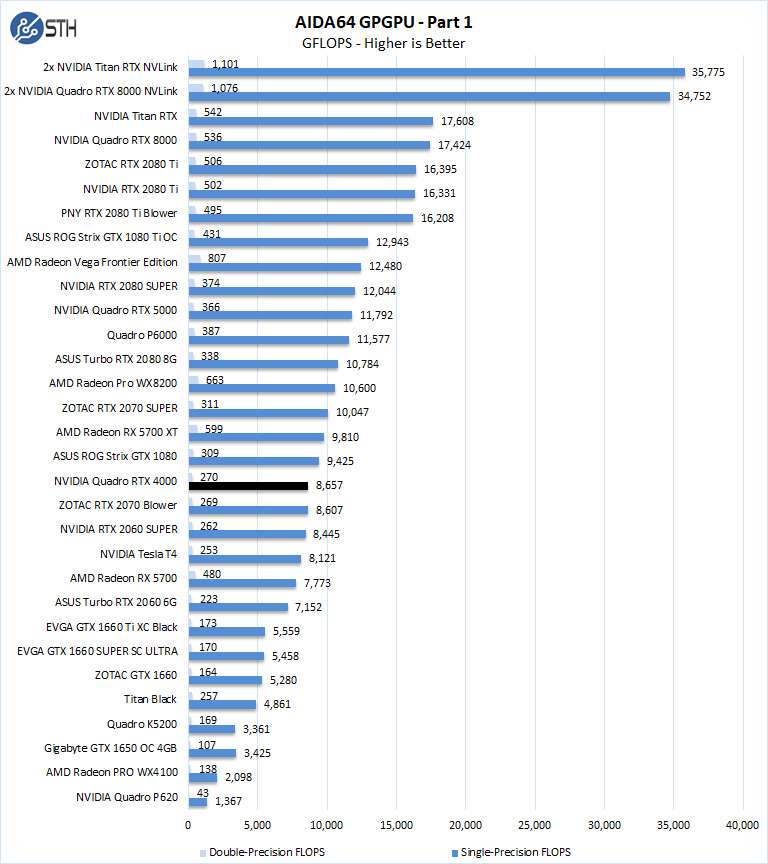
The next set of benchmarks from AIDA64 are:
- 24-bit Integer IOPS: Measures the classic MAD (Multiply-Addition) performance of the GPU, otherwise known as IOPS (Integer Operations Per Second), with 24-bit integer (“int24”) data. This particular data type defined in OpenCL on the basis that many GPUs are capable of executing int24 operations via their floating-point units.
- 32-bit Integer IOPS: Measures the classic MAD (Multiply-Addition) performance of the GPU, otherwise known as IOPS (Integer Operations Per Second), with 32-bit integer (“int”) data.
- 64-bit Integer IOPS: Measures the classic MAD (Multiply-Addition) performance of the GPU, otherwise known as IOPS (Integer Operations Per Second), with 64-bit integer (“long”) data. Most GPUs do not have dedicated execution resources for 64-bit integer operations, so instead, they emulate the 64-bit integer operations via existing 32-bit integer execution units.
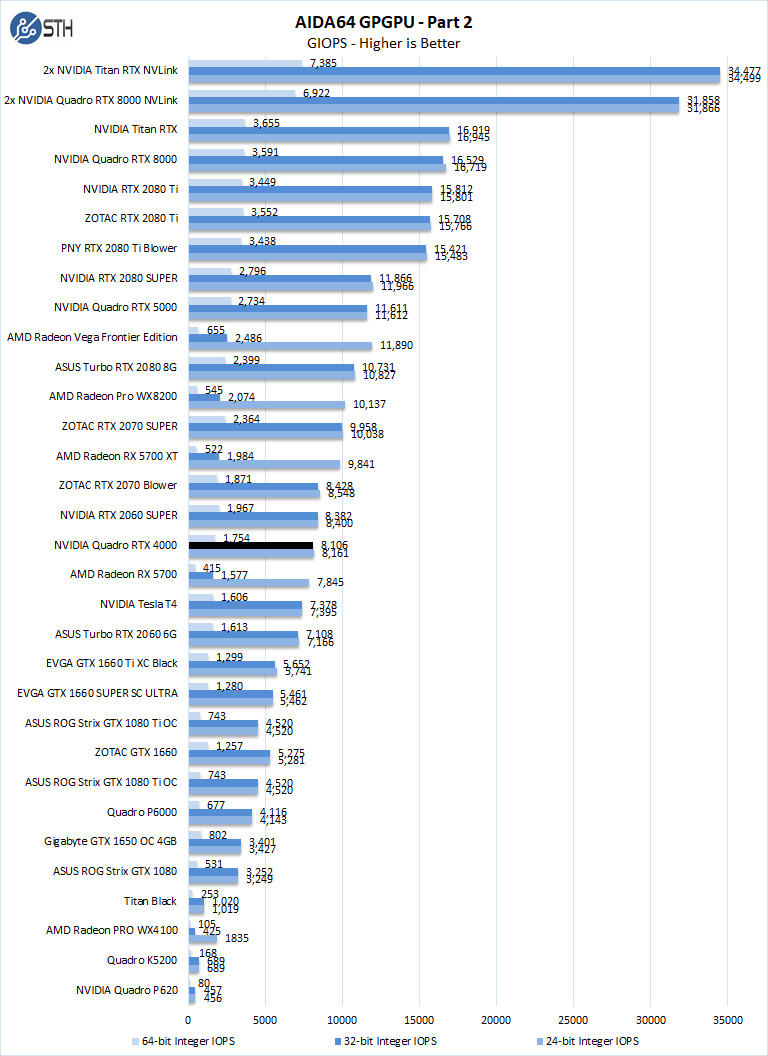
The takeaway here is the NVIDIA Quadro RTX 4000 archives near ZOTAC RTX 2070 Blower performance.
hashcat64
hashcat64 is a password cracking benchmarks that can run an impressive number of different algorithms. We used the windows version and a simple command of hashcat64 -b. Out of these results, we used five results in the graph. Users who are interested in hashcat can find the download here.
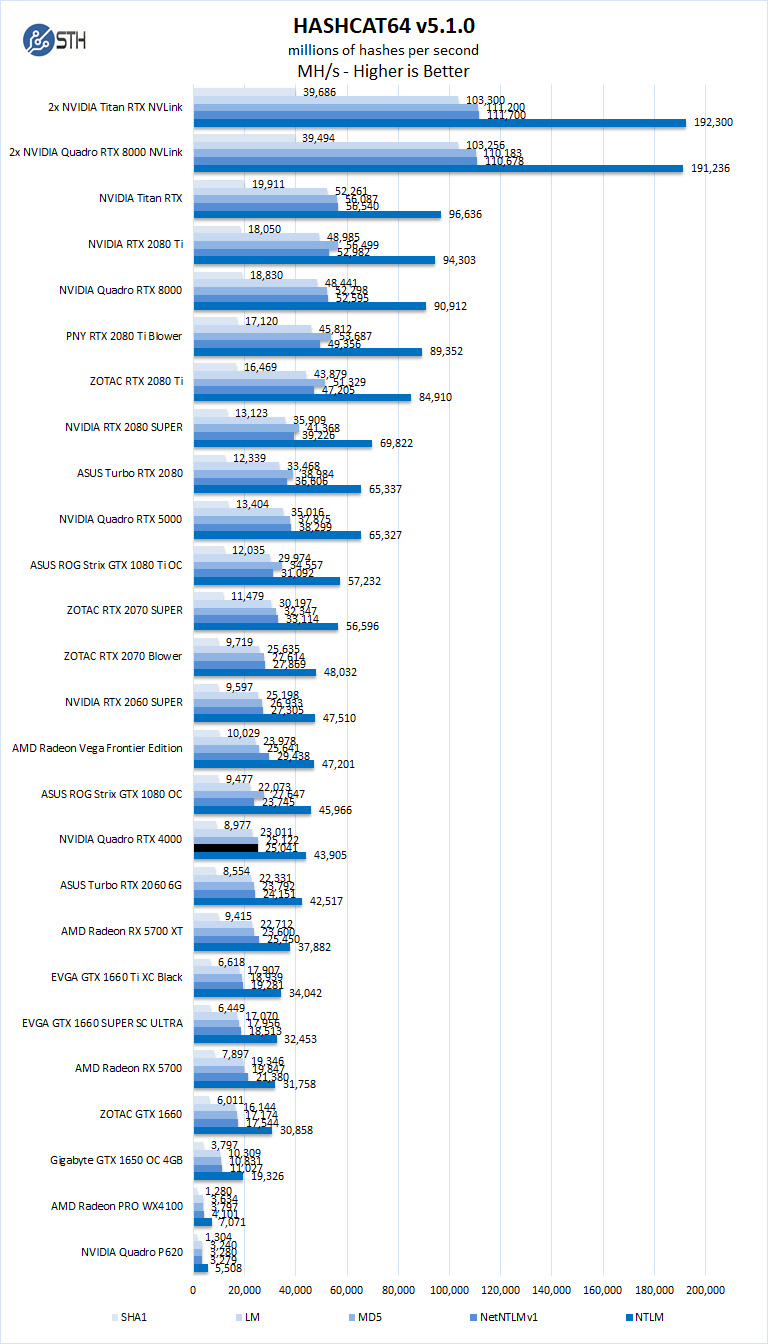
Hashcat can put a heavy load on GPU’s, and here we see the dual-fan graphics cards have the edge in our results. This pushes the Quadro RTX 4000 closer to the ASUS Turbo-RTX2060-6G results.
SPECviewperf 13
SPECviewperf 13 measures the 3D graphics performance of systems running under the OpenGL and Direct X application programming interfaces.
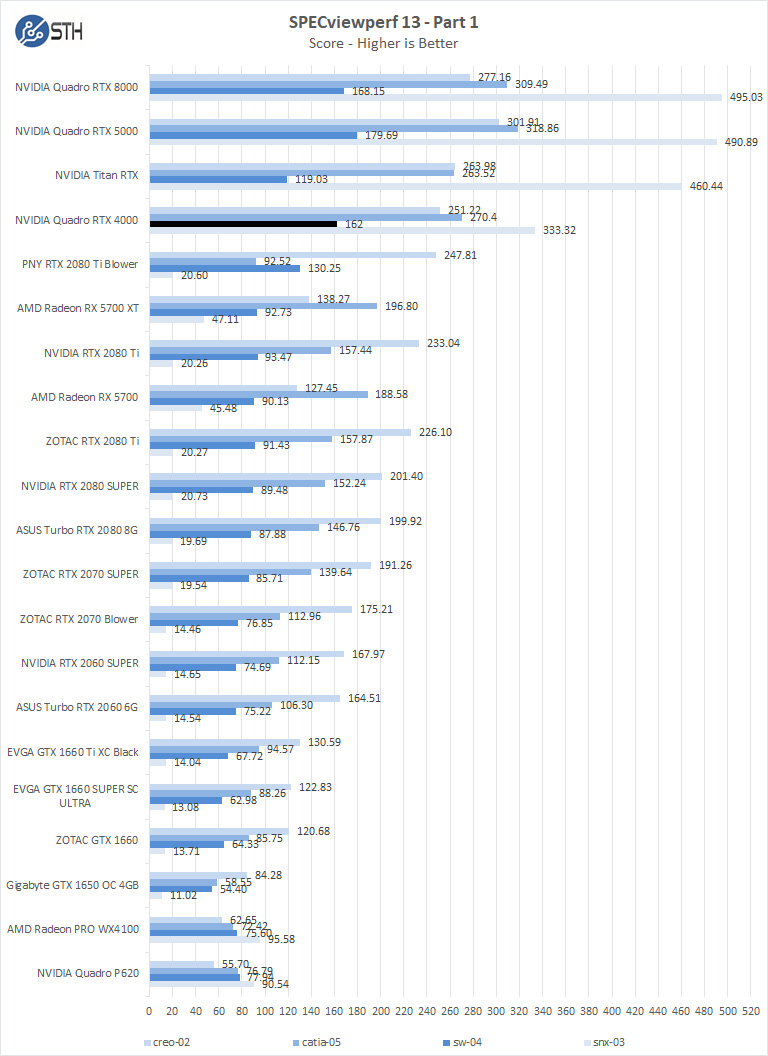
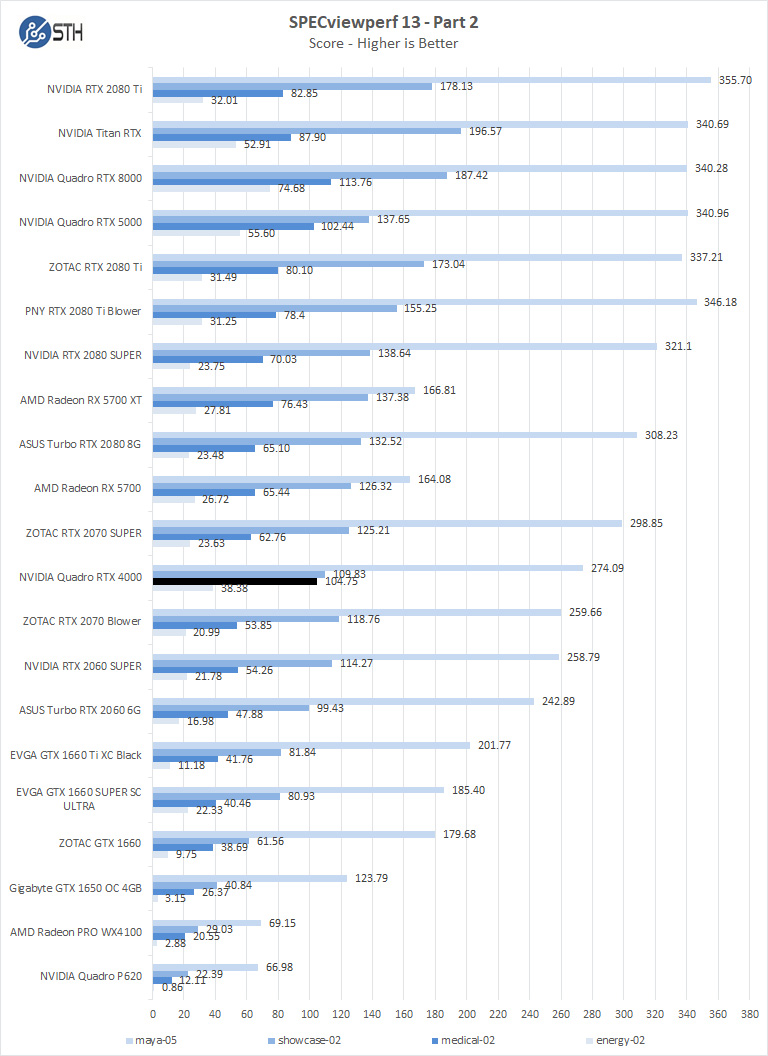
In SPECviewperf, the Quadro RTX 4000 performs well. If you are looking for better performance, the larger NVIDIA Quadro RTX 5000 may be worth consideration even though it is more expensive and uses more space/ power. This is where the bigger coolers help a lot.
Let us move on and start our new tests with rendering-related benchmarks.


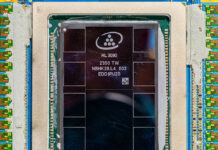

The Quadro RTX 4000 has served me well at work in an external Thunderbolt GPU chassis as a portable production GPU. It is an interesting use case as the raw GPU performance was not as critical as getting several check boxes marked on the feature set which precluded many of the lower end Quadros and made anything higher end pure overkill.
One of the requisite features was support for the Quadro Sync II board so that it can be gen-locked with various video production equipment. Since the Quadro RTX 4000 is a single slot board, the Quadro Sync II card fit in with the external GPU chassis. Note that the gen lock board can mount into a PCIe slot, all communication with the GPU card is done via ribbon cables. In a small tower system, I’ve rigged up the same genlock board inside a front panel bay to save on slot spacing.
One of the more interesting things I’ve recently tested has been with nVidia voice where this graphics card get pulled in to do some audio processing in recent months.
The one thing on my wish list for any future nVidia A4000 replacement card would be include Thunderbolt 4 ports on the GPU itself instead of Virtual-Link. It’d be far more useful and there are a handful of video production boxes with Thunderbolt 3 interfaces that could hypothetically communicate directly with the A4000’s hardware video encoders, reducing latency for real time encoding by a few critical hairs. Similarly, an HDMI 2.1 port would be valuable for the video production area that I’ve been involved in lately as a DisplayPort to HDMI adapter would not be necessary for display. Though for a multidisplay system where timing is critical, having all the ports leveraging the same adapters does equalize time vs. one native HDMI port and multiple DP ports with active adapters.
I have installed the NVIDIA RTX 4000 on my Intel s2600stbr motherboard with 256GB ram and two 10 core intel Xeon silver 4210 CPUs with windows 10 pro for workstations, and got the message after compatibility check that due to programs running in the background or OS incompatible, can anyone help with this.
I have an RTX 4000 in my Dell Precision T7610 with two 10 core Xeons and 128gb RAM. Very strangely the machine totally refused to boot up with the RTX card in the PCI-E 16x slot that in intended for the GPU card, so I removed it and put it in the lower PCI-E 16x slot and it’s fine. Bit weird but there we go.
It runs hot. Even with the case fans running fairly energetically it was in the 80’s on full load. I’ve put a slot-fan both above and below the card forcing more air to blow all over it and it’s shaved about 10 degrees off, much better. But now I’m using three slots for a single slot card, which defeats the object somewhat!
Lovely card though.